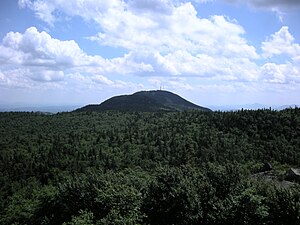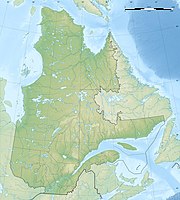Parc national du Mont-Orford
|
Parc national du Mont-Orford
|
||
|
View of Mont-Orford from the Pic de l'Ours |
||
| location | Quebec , Canada | |
| surface | 58.37 km² | |
| WDPA ID | 66606 | |
| Geographical location | 45 ° 20 ′ N , 72 ° 13 ′ W | |
|
|
||
| Setup date | 1979 | |
| administration | Parcs Québec, SEPAQ | |
The Mont-Orford National Park or Parc national du Mont-Orford is one of the current 27 national parks in the Canadian province of Québec . There a parc national corresponds to what is called a provincial park in the other provinces . The park is operated by Sépaq ( French Société des établissements de plein air du Québec or English Society of outdoor recreation establishments of Quebec ) and is the oldest of the provincial parks in Québec.
The task of the 58.37 km² park, which was set up in 1979 in the extreme south of the province south of the Saint Lawrence River , is to protect and represent the area around the eponymous mountain. The park is west of Sherbrooke and north of Magog . To avoid recreational activities from destroying the ecosystem, they are restricted to certain areas. There is a concert hall with the Center d'art Orford, and the mountain is also a skiing and hiking area. The two most important lakes are Lac Fraser and Lac Stukely ; The two sectors of the small park are named after them.
history
In 1938 the surrounding communities agreed to protect the mountain from industrial use (development). A golf course was built a few years later. In the course of Expo 67 , the Center d'art Orford was built, and a ski station soon followed. In 1976 the government expanded the area of the park from about 40 to 58.37 km². Initially, she wanted to remove the facility from the park, but in 1979 it was decided that the park should serve both ecological and recreational purposes.
In 2005, lobby groups in the real estate and construction industries began to exert their influence on the government. They managed to get Québec to give permission to build the ski station in the middle of the park on 649 hectares of accommodation for around 1000 visitors. Against this, the group SOS Parc Orford organized resistance because it considered it illegal. The responsible Ministère du Développement durable, de l'Environnement et des Parcs (Ministry for Sustainable Development, Environment and Parks) responded by offering to double the park area. SOS Parc Orford refused, stating that these were ecologically poor areas and that this could in no way compensate for the loss of the most important area in the park in this respect. On April 21, 2006, eight former park directors wrote an open letter to the government, and the next day 12,000 people demonstrated in Montréal against the construction plans. The government has now reduced the building area to 579 hectares, but on May 7, 2007 it failed to find a majority in parliament. Still, she did not withdraw the law that made this sale possible. Only with the law concerning the Mont-Orford National Park, the loi concernant le parc national du Mont-Orford of May 26, 2010, were the leisure facilities and the planned construction sites reintegrated into the park and the golf course renatured.
Flora and fauna
Overall, the ecosystem is not only threatened by the tourism and entertainment industry or the construction industry and real estate business, but also from the periphery. On the one hand, there is still hunting there, on the other hand, the leisure industry is attracting road traffic, which is causing a corresponding increase in the number of animal accidents. In addition, drainage and sealing in favor of hotels and leisure facilities in the neighborhood damage the water system.
Snapping turtles and ornamental turtles live in the numerous ponds and pools of the park , with the raccoon being the most dangerous egg predator.
A pair of peregrine falcons have been nesting at Pic aux Corbeaux since 2008, a success of the 2002 campaign to reintroduce these birds to southern Québec.
The campfire, which is common in all Canadian parks, poses great dangers for the insect world, as unused wood is often taken from one park to the next. In the process, new species are unintentionally introduced, including those that cause tree diseases.
See also
literature
- The research scientifique dans les Parcs nationaux québécois. Priorités et potentiels de recherche , published by Parcs Québec and Sépaq, undated, pp. 95–98.
Web links
- Parc national du Mont-Orford , Sépaq (French)
Remarks
- ↑ Béchard vendra le mont Orford aux Promoteurs. Les profits serviront à agrandir le parc national , in: Le Devoir, 7 March 2006.
- ↑ Mont Orford. Grande marche contre la privatatisation , Radio Canada, April 22, 2006.
- ↑ Orford: volte-face de Québec , in: Le Devoir, May 8, 2007.
- ↑ Assemblée nationale du Québec: Loi concernant le parc national du Mont-Orford , chapitre 9 (PDF; 305 kB).


